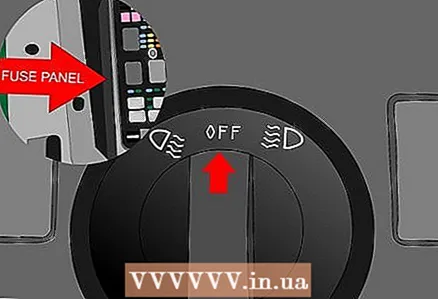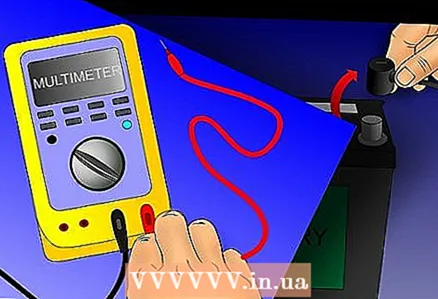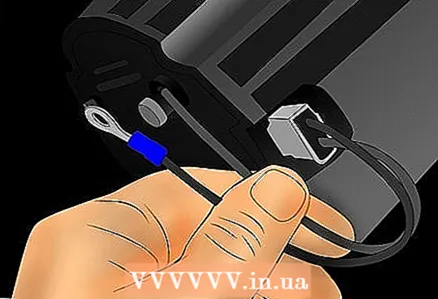Author:
Bobbie Johnson
Date Of Creation:
7 April 2021
Update Date:
1 July 2024

Content
Your car battery is completely discharged overnight, or your car battery is depleted when you leave something on, such as a light. Sometimes, something that you are not aware of is consuming battery power.These are parasitic leaks, and they can cause the same result if the headlights are left on: the battery will drain in the morning.
Steps
 1 Remove the negative probe from the battery terminal.
1 Remove the negative probe from the battery terminal. 2 Connect the black wire to the negative input of the multimeter and the red wire to 10A or 20A on the multimeter. The meter must see at least 2 or 3 amperes for this measurement to work correctly. Connecting the red wire to the mA input of the multimeter is not suitable and may damage the meter.
2 Connect the black wire to the negative input of the multimeter and the red wire to 10A or 20A on the multimeter. The meter must see at least 2 or 3 amperes for this measurement to work correctly. Connecting the red wire to the mA input of the multimeter is not suitable and may damage the meter.  3 Connect a multimeter (set the handle of the multimeter to measure current according to the instructions) between the negative test lead and the negative pole of the battery. Wait from a few seconds to several minutes to put the car into sleep mode - that is, when you connect the ammeter, the car computer systems "wake up". After a while, they will return to "sleep" again.
3 Connect a multimeter (set the handle of the multimeter to measure current according to the instructions) between the negative test lead and the negative pole of the battery. Wait from a few seconds to several minutes to put the car into sleep mode - that is, when you connect the ammeter, the car computer systems "wake up". After a while, they will return to "sleep" again.  4 If the ammeter outputs more than 25-50 milliamps, something is using too much battery power.
4 If the ammeter outputs more than 25-50 milliamps, something is using too much battery power. 5 Go to the fuse panel and remove all fuses one by one. Pull out the main (higher current) fuses last. Follow the same steps for the relays that you find on the fuse panel. Sometimes the relay contacts may fail to disconnect and cause leakage. Be sure to observe the current on the ammeter by disconnecting each fuse or relay.
5 Go to the fuse panel and remove all fuses one by one. Pull out the main (higher current) fuses last. Follow the same steps for the relays that you find on the fuse panel. Sometimes the relay contacts may fail to disconnect and cause leakage. Be sure to observe the current on the ammeter by disconnecting each fuse or relay.  6 Watch the ammeter when the reading has dropped to the acceptable value for leakage. The fuse that reduces the leakage must be pulled out. Refer to the manual or service manual to determine which circuit is on a given fuse.
6 Watch the ammeter when the reading has dropped to the acceptable value for leakage. The fuse that reduces the leakage must be pulled out. Refer to the manual or service manual to determine which circuit is on a given fuse.  7 Check each device (circuit) on this fuse. Unplug every light, heater, every electrical device in turn to find the leak.
7 Check each device (circuit) on this fuse. Unplug every light, heater, every electrical device in turn to find the leak.  8 Repeat steps 1 and 2 to check the result of your repair. The ammeter will show you the exact value.
8 Repeat steps 1 and 2 to check the result of your repair. The ammeter will show you the exact value.  9 You can also try decoupling the large wire from the alternator. The generator can sometimes have a short-circuit diode which can leak current through the generator power cable and through the short-circuit diode, fuse box clamps and back to the negative terminal of the battery. This will cause the battery to drain quickly. Remember to check the ammeter reading before and after turning off the alternator.
9 You can also try decoupling the large wire from the alternator. The generator can sometimes have a short-circuit diode which can leak current through the generator power cable and through the short-circuit diode, fuse box clamps and back to the negative terminal of the battery. This will cause the battery to drain quickly. Remember to check the ammeter reading before and after turning off the alternator.
Tips
- A parasitic leak occurs when electrical appliances are powered by a battery, the car is locked and there is no key in the ignition. Thus, when performing this check, make sure that the low beam, the lights under the hood and trunk off.
Warnings
- Exercise caution when working with an automotive electrical system. Protect your eyes and skin. Likewise, remember that the changes made to the electrical system must be within the normal range (correctly installed fuses with the required amperage) when adding or replacing anything electrical, whether it is an aftermarket replacement or replacement of parts from the original equipment manufacturer).
- In an increasing number of models made after 2003, disconnecting the battery will reset the powertrain control module (PCM) requiring the modules to be retrained. In some cases, this requires factory scanning tools. It is best to give such vehicles either to a car dealer or an expert on automotive electrical systems.
- Remember to check your cigarette lighter and outlet. Sometimes coins can fall in there and cause a short circuit.
- Some aftermarket alarm systems can interfere with the inspection by making it too long or noisy and not worth the effort. If so, you need to seek professional help.
- Be careful when handling a battery in a vehicle.
What do you need
- Protective glasses
- Digital multimeter or ammeter.
- Fuse remover. (You can also use pliers, but be careful not to crush the fuse.)
- Any tools required to gain access to the battery and safety panel (s).
- User manual or electrical circuit maintenance manual.



